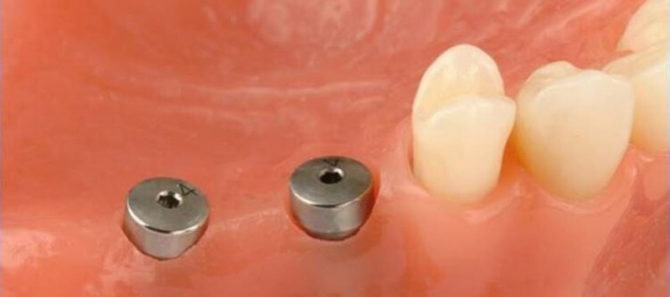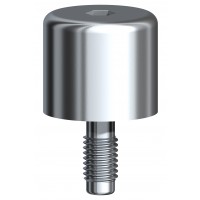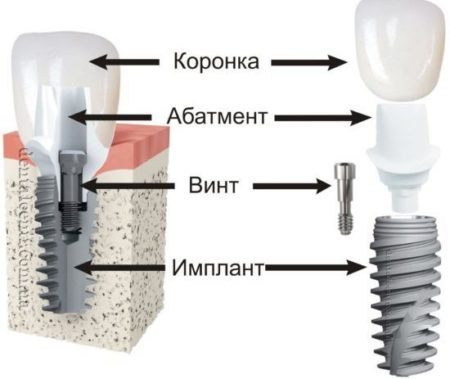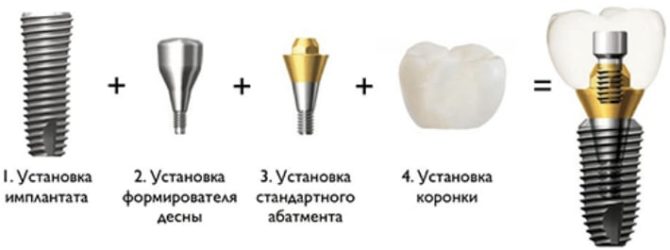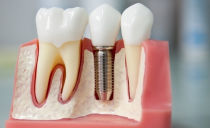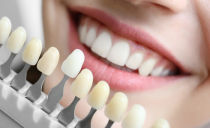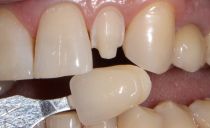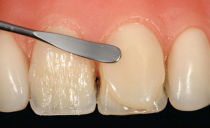Implant Gum Shaper: what is it, how is it installed
Many put white and even artificial crowns on implants. But few people think that not only the dentition, but also the gum, which has lost its natural contour in the area where the tooth fell out, needs restoration. That's why One of the stages of implantation is the installation of a gingival former.
Content
Description of the gingiva former, for which it is placed
The purpose of the shaper is to create a natural gingival contour around the denture. The beauty of the dentition depends on the correctness of its installation.
Externally, the product resembles a metal bolt, on a cylindrical leg of which a tight thread is applied. The shaper is screwed directly to the implanted implant and firmly fixed so that it does not fall out. The size and shape of the product are selected individually for each patient and depend on the size and location of the future denture.
Shapers can be made of the following materials:
- titanium;
- zirconium;
- plastic;
- ceramics.
Specialists prefer to work with titanium products, because this material is durable and not subject to corrosion. In addition, this design does not create an extra load on the root implant. But titanium formers have one significant drawback: they are visible through the gum, which significantly spoils the appearance of the dentition. Therefore, specialists use products made from alternative materials to restore gingival tissue in the anterior teeth.
Why it is so important to form the correct gingival contour around the implant is described in the video:
Abutment and shaper - differences
The stages of tooth implantation include the installation of not only the healing abutment, but also the abutment. Both designs have a similar structure, but the purpose in dentistry is different for them. The abutment is placed after the final formation of the gums, it is screwed into the implant instead of the shaper.
The function of the abutment is to give extra strength to the denture. Abutments are temporary, angular, cast (soldered with implants), standard, individual.
Implantation Stages
Implantation is a long and complicated procedure, consisting of several stages:
- Jaw bone growth (if necessary).
- Installation of artificial root (implant).
- Screwing in the shaper.
- Abutment installation.
- Prosthetics.
Shaper Installation Process
The installation of a gingiva former on the implant is regarded as a micro-operation. The procedure is performed in two ways:
- At the same time - screwing the product is performed on the day the implant is inserted into the bone tissue.
- Standard - done after a few months, when the root prosthesis takes root. Unlike a one-time procedure, the standard one lasts a long time.
The shaper is installed in the following sequence:
- Local anesthesia.
- Gum incision to gain access to the implant.
- Removal of excess overgrown tissues.
- Removing a stub from an artificial root.
- Screwing in the forming structure.
- Contraction of the wound using medical sutures.
Local anesthesia blocks pain during microoperation. At the end of the action of the anesthetic, slight soreness is possible. Normally, discomfort lasts no more than one week.
After the procedure, the gum heals, and the shaper gradually overgrows with soft tissue. Typically, a postoperative wound heals within 1–2 weeks. How much concrete time is needed to form an even gingival contour, the doctor determines.
Complications after installing the forming structure
Surgery is always stressful. And since the body of each person is individual, it is difficult to predict the consequences of microoperation. Therefore, doctors always warn about the possibility of complications, among which:
- Allergic reaction. Dental products used during implantation are made of hypoallergenic alloys. But to predict the patient's response to the use of drugs is impossible. Therefore, before the procedure, an allergy test is performed. If, despite precautionary measures, an allergic reaction has occurred, the doctor prescribes antihistamines.
- Bleeding of sutures and gums. While the postoperative wound is healing, it is recommended to rinse the mouth with decoctions of herbs or special pharmaceutical solutions.
- Swelling of the gums. A common reaction after surgery is the appearance of edema in the cheek or gum region. Usually the swelling subsides quickly. But it is possible that edema indicates a strong compression of the gums. In this case, it is necessary to change the former.
- Sore throat, neck, in the area of the prosthesis. Appears when the doctor's instructions are not followed in the postoperative period. Neglect of hygiene rules is fraught with the development of gingival inflammation. Therefore, in order to ensure safety after surgery, antibiotics and antiseptic treatment of sutures are prescribed.
How to recognize installation errors and what to do
The installed shaper looks like a metal cap that rises slightly above the gum. The operation of screwing the structure directly affects the quality of further prosthetics. If the manipulations are performed professionally, then after installing the forming structure, the patient will not experience discomfort for a long time.
Situations indicating that the installation of the forming structure was carried out incorrectly:
- The design staggers and falls out. You should not do anything yourself - if the gingiva former is staggering or has fallen out, you should immediately consult a doctor so that he screwed it back into the implant. Otherwise, the hole will overgrow, and a new surgical intervention will be required. Loss of construction due to improperly sized or poor installation.
- The gum has grown on the product in whole or in part. So, the shaper height is incorrectly selected. With proper installation, soft tissues should not cover the structure, otherwise it will be difficult to carry out further stages of prosthetics.
- The design makes it difficult to chew. So they are too big. It is necessary to put a shaper suitable for height, otherwise damaged gingival tissues will slowly heal. Please note that the metal structure is not a finished tooth. Therefore, it always looks and is felt in the oral cavity as a foreign body.
- The part is not level. The doctor will correct the situation using angled abutment.
Implantation during pregnancy
In the second trimester of pregnancy, doctors allow the installation of the shaper only in case of emergency. And I and III trimesters are considered categorical contraindications to the manipulation.
Microsurgery for the formation of gums is performed using local anesthesia.Taking medications can adversely affect the condition of the fetus, so doctors recommend that you refrain from implantation until the postpartum period.
Oral care during gum formation
How long the healing and restoration process of damaged gingival tissue will last depends on the patient's behavior. For several hours after installing the shaper, you can not eat food, drink tonic drinks. You can drink warm water. On the day of its installation, you must refrain from smoking.
In the first two days after surgery, food is taken only in pureed form. Dishes must be warmed to room temperature. Hot and cold foods are not allowed to be used until the wound has healed.
Prevention of complications is carried out using rinses of the oral cavity:
- unsaturated solution of iodized or sea salt;
- a decoction of valerian;
- infusion of chamomile;
- a weak solution of hydrogen peroxide.
In the first weeks after the gum formation manipulation, physical activity is contraindicated. Postpone trips, jogging, do not go to fitness and dancing. If professional activity is associated with significant physical exertion, then while the wounds heal, take a short vacation. It is recommended not to go to saunas and baths.
During the rehabilitation period, drug therapy is indicated, which facilitates the general condition and accelerates the healing of injured gum tissue. Be sure to adhere to the medication prescribed by the doctor. How many tablets to take and their dosage is determined only by the doctor.
Be sure to brush your teeth daily. The procedure is carried out twice a day using a brush with soft bristles and medical and preventive toothpaste, it is not worth brushing your teeth for a long time. Plaque is removed very carefully so as not to damage the sutures and cause bleeding. After each meal, you can rinse your mouth with special pharmacy products.
Installation cost
The cost of installing the shaper includes the price of the product and the cost of the costs of the manipulation itself. According to the cost of construction, they are divided into 3 classes:
- economy;
- business;
- premium.
The most liberal prices are set by manufacturers from Israel. Premium and business class shapers are made by companies in America, Switzerland and Germany. When implanting, you can combine designs from different price categories, but specialists prefer to use products of the same brand.
Dental implantation has truly become a salvation for a person in pursuit of a white-toothed smile. Implants are so identical to natural teeth that patients increasingly prefer their removable dentures and bridges. But remember that artificial teeth also need special care. Do not forget to clean them daily and go to the dentist regularly.
The video answers all the important questions that arise during the planning of dental implants and at the moment when the gums heal:

